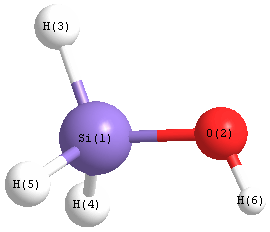Vibrational Frequencies calculated at B2PLYP=FULLultrafine/6-31G*
| Mode Number |
Symmetry |
Frequency
(cm-1) |
Scaled Frequency
(cm-1) |
IR Intensities
(km mol-1) |
Raman Act
(Å4/u) |
Dep P |
Dep U |
|---|
| 1 |
A' |
3837 |
3640 |
70.29 |
86.60 |
0.29 |
0.45 |
| 2 |
A' |
2329 |
2210 |
140.83 |
96.78 |
0.26 |
0.41 |
| 3 |
A' |
2273 |
2157 |
125.75 |
149.07 |
0.08 |
0.16 |
| 4 |
A' |
1046 |
992 |
241.03 |
16.85 |
0.70 |
0.83 |
| 5 |
A' |
996 |
945 |
125.93 |
18.25 |
0.75 |
0.86 |
| 6 |
A' |
929 |
882 |
78.80 |
12.81 |
0.75 |
0.86 |
| 7 |
A' |
858 |
814 |
143.26 |
8.65 |
0.19 |
0.32 |
| 8 |
A' |
703 |
667 |
73.29 |
6.38 |
0.68 |
0.81 |
| 9 |
A" |
2268 |
2151 |
238.02 |
62.17 |
0.75 |
0.86 |
| 10 |
A" |
965 |
916 |
98.73 |
22.29 |
0.75 |
0.86 |
| 11 |
A" |
739 |
701 |
83.72 |
11.72 |
0.75 |
0.86 |
| 12 |
A" |
227 |
215 |
122.58 |
2.57 |
0.75 |
0.86 |
Unscaled Zero Point Vibrational Energy (zpe) 8584.9 cm
-1
Scaled (by 0.9487) Zero Point Vibrational Energy (zpe) 8144.5 cm
-1
See section
III.C.1 List or set vibrational scaling factors
to change the scale factors used here.
See section
III.C.2
Calculate a vibrational scaling factor for a given set of molecules
to determine the least squares best scaling factor.
Charges, Dipole, Quadrupole and Polarizability
Charges from optimized geometry at B2PLYP=FULLultrafine/6-31G*
Charges (e)
| Number |
Element |
Mulliken |
CHELPG |
AIM |
ESP |
| 1 |
Si |
0.634 |
|
|
|
| 2 |
O |
-0.739 |
|
|
|
| 3 |
H |
-0.092 |
|
|
|
| 4 |
H |
-0.115 |
|
|
|
| 5 |
H |
-0.115 |
|
|
|
| 6 |
H |
0.428 |
|
|
|
Electric dipole moments
Electric dipole components in Debye
(What's a Debye? See section
VII.A.3)
| |
x |
y |
z |
Total |
| |
-1.514 |
-0.030 |
0.000 |
1.515 |
| CHELPG |
|
|
|
|
| AIM |
|
|
|
|
| ESP |
|
|
|
|
Electric Quadrupole moment
Quadrupole components in D Å
| Primitive |
|---|
| | x | y | z |
|---|
| x |
-19.795 |
-3.132 |
0.005 |
| y |
-3.132 |
-20.305 |
0.013 |
| z |
0.005 |
0.013 |
-21.788 |
|
| Traceless |
|---|
| | x | y | z |
|---|
| x |
1.251 |
-3.132 |
0.005 |
| y |
-3.132 |
0.486 |
0.013 |
| z |
0.005 |
0.013 |
-1.738 |
|
| Polar |
|---|
| 3z2-r2 | -3.475 |
|---|
| x2-y2 | 0.510 |
|---|
| xy | -3.132 |
|---|
| xz | 0.005 |
|---|
| yz | 0.013 |
|---|
|
Polarizabilities
Components of the polarizability tensor.
Units are
Å
3 (Angstrom cubed)
Change units.
| |
x |
y |
z |
| x |
3.579 |
-0.127 |
-0.000 |
| y |
-0.127 |
3.545 |
-0.000 |
| z |
-0.000 |
-0.000 |
3.338 |
<r2> (average value of r
2) Å
2
| <r2> |
39.393 |
| (<r2>)1/2 |
6.276 |
